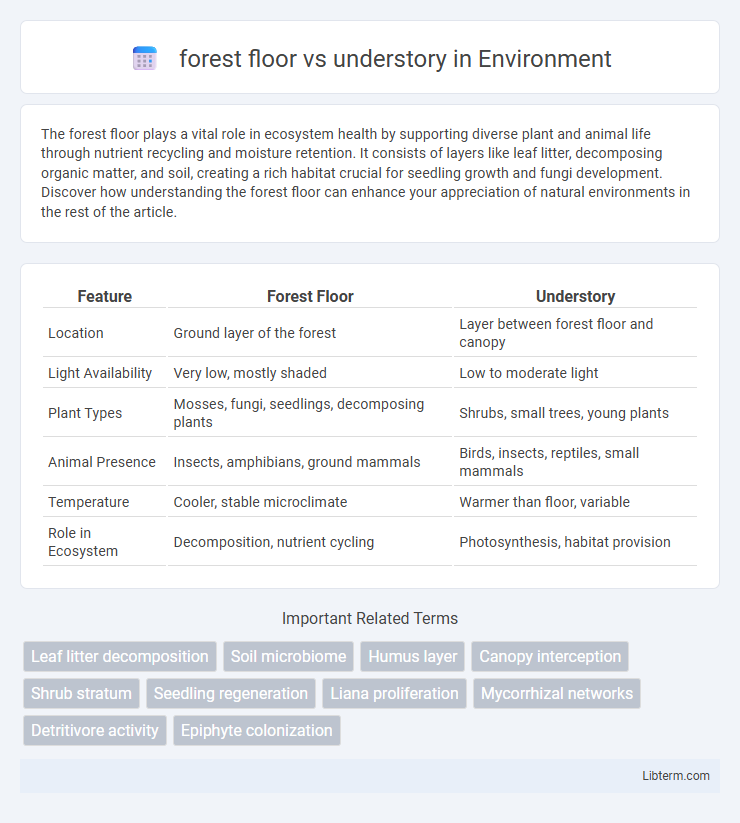The forest floor plays a vital role in ecosystem health by supporting diverse plant and animal life through nutrient recycling and moisture retention. It consists of layers like leaf litter, decomposing organic matter, and soil, creating a rich habitat crucial for seedling growth and fungi development. Discover how understanding the forest floor can enhance your appreciation of natural environments in the rest of the article.
Table of Comparison
| Feature | Forest Floor | Understory |
|---|---|---|
| Location | Ground layer of the forest | Layer between forest floor and canopy |
| Light Availability | Very low, mostly shaded | Low to moderate light |
| Plant Types | Mosses, fungi, seedlings, decomposing plants | Shrubs, small trees, young plants |
| Animal Presence | Insects, amphibians, ground mammals | Birds, insects, reptiles, small mammals |
| Temperature | Cooler, stable microclimate | Warmer than floor, variable |
| Role in Ecosystem | Decomposition, nutrient cycling | Photosynthesis, habitat provision |
Defining the Forest Floor and Understory
The forest floor constitutes the lowest layer of a forest ecosystem, covered by soil, organic matter, fallen leaves, and decomposing plant material that supports nutrient cycling and habitat for decomposers. The understory is the layer above the forest floor, populated by young trees, shrubs, and shade-tolerant plants that thrive under the canopy's filtered light. Both layers play crucial roles in forest structure, biodiversity, and ecological processes such as photosynthesis and habitat provision.
Key Differences Between Forest Floor and Understory
The forest floor is the lowest layer of the forest, characterized by decomposing leaves, organic matter, and limited sunlight, supporting fungi, insects, and small plants like mosses. The understory lies above the forest floor and consists of shrubs and young trees adapted to low light, serving as habitat for birds and mammals. Key differences include sunlight availability, vegetation type, and primary ecological functions, with the forest floor facilitating nutrient recycling and the understory providing shelter and food sources.
Typical Vegetation Found on the Forest Floor
The forest floor hosts typical vegetation such as mosses, ferns, seedlings, and decomposing organic matter, thriving in low light and high humidity conditions. This layer supports fungi and bacteria essential for nutrient recycling, enabling plant growth above. Unlike the understory, which consists mainly of shrubs and young trees, the forest floor remains closest to the soil, rich in leaf litter and minimal sunlight.
Common Plants and Species in the Understory
The understory of a forest typically hosts shade-tolerant plants such as ferns, shrubs, and young saplings of canopy trees like oak, maple, and birch. Common species include American holly, spicebush, and mountain laurel, which thrive in lower light conditions beneath the canopy. These plants play a crucial role in habitat diversity and nutrient cycling within the forest ecosystem.
Light Availability and Environmental Conditions
The forest floor receives minimal light, often less than 2% of full sunlight, creating dim and cooler environmental conditions that limit photosynthesis. In contrast, the understory captures filtered sunlight ranging from 2% to 15%, supporting a diverse array of shade-tolerant plants adapted to moderate light and higher humidity. These differences in light availability and microclimate significantly influence species composition and ecological processes in each forest layer.
Role in Forest Ecosystem Dynamics
The forest floor plays a critical role in nutrient cycling by decomposing organic matter and supporting soil microorganisms that enrich the soil, while the understory contributes to forest dynamics through providing habitat for diverse wildlife and acting as a buffer layer that influences light penetration and microclimate conditions. Together, these layers regulate seedling growth and biodiversity by maintaining soil moisture and temperature, facilitating plant regeneration and succession processes. Their interactions drive energy flow and carbon storage crucial for maintaining forest ecosystem stability and resilience.
Nutrient Cycling in the Forest Floor vs Understory
Nutrient cycling in the forest floor is driven by the decomposition of organic matter such as fallen leaves, dead wood, and other plant debris, which releases essential nutrients like nitrogen, phosphorus, and potassium back into the soil. In contrast, the understory plays a role in nutrient uptake and redistribution, as its dense vegetation absorbs nutrients from the soil and organic material, often facilitating nutrient transfer through root networks and litterfall. This dynamic interaction between the forest floor and understory maintains soil fertility and supports overall forest ecosystem productivity.
Animal Habitats: Forest Floor and Understory Fauna
The forest floor provides a habitat rich in decomposing leaves, soil, and low-lying plants, supporting ground-dwelling animals such as insects, amphibians, and small mammals. The understory, characterized by dense shrubs and young trees, offers shelter and food sources for birds, reptiles, and arboreal mammals, creating a layered ecosystem crucial for biodiversity. Both layers contribute to forest health by sustaining varied animal populations that perform roles in nutrient cycling and seed dispersal.
Human Impact on Forest Floor and Understory Layers
Human activities such as logging, agriculture, and urban development significantly disrupt the forest floor by compacting soil, reducing leaf litter, and altering nutrient cycles critical for seedling growth and microbial communities. In the understory layer, habitat fragmentation and invasive species introduction from human interference diminish native plant diversity and disrupt animal habitats reliant on dense vegetation for shelter and food. Conservation efforts targeting minimal disturbance and restoration of native species can help mitigate the negative effects on these vital forest layers.
Conservation Strategies for Forest Floor and Understory
Effective conservation strategies for the forest floor and understory prioritize maintaining biodiversity and ecological functions by protecting native plant species and microhabitats. Implementing controlled burns and selective thinning preserves nutrient cycling and light availability, fostering regeneration of understory vegetation crucial for wildlife habitat. Monitoring invasive species and minimizing soil compaction through restricted human access safeguards the delicate balance of forest floor communities and understory dynamics.
forest floor Infographic

 libterm.com
libterm.com